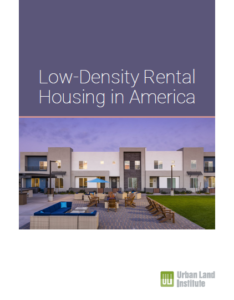
Building off the Terwilliger Center’s Family Renter Housing and Attainable Housing reports, this new report focuses on strategies and models for building purpose built single-family or townhome – low- and mid-density rentals (SFR). There is an emerging and still undefined spectrum of innovative housing that serves a product want and need between garden apartments and traditional single-family homes.
Low-Density Rental Housing in America is the first report that codifies the SFR market’s language, product types and differentiating characteristics. The report looks at three general ownership models and structures to define the three product types of SFRs:
- Small-scale investors/owners: Representing more than 97 percent of the existing market, small-scale investors generally own few properties and lack the scale for operating and marketing efficiencies. Their listings are typically available on online marketplaces. The main difference between small-scale investment stock and aggregated portfolios is the diversity of inventory quality.
- Institutional SFR aggregators/scattered site: Representing the initial institutionalization of SFRs, these businesses aggregated homes across various markets and states following the Great Financial Crisis. This partner works with homebuilders to purchase blocks of new-construction homes in bulk to add to their portfolios. This reduces market risks for homebuilders while allowing institutional aggregators the scale needed for capital deployment.
- Purpose-built SFR communities/Build-for-Rent: The newest of the three, this category includes communities specifically designed and dedicated to SFR housing. These communities incorporate consistent branding, housing quality and vintage. They function much like an apartment complex, only for single-family homes.
The Low-Density Rental Housing in America report also outlines key characteristics of each unique purpose-built SFR model demonstrating the success of each one:
- Horizontal multifamily: composed of dense one-story single family detached (SFD) units, as well as townhouses and duplexes for the smallest units, horizontal multifamily communities can achieve densities of nine to 14 dwelling units per acre. These communities generally offer between 100-150 units. They are typically developed on land zoned for commercial or multifamily uses, given the density and construction configuration of the project.
- Build-for-rent single-family attached: These housing options encompass a broad spectrum of community configurations, unit types and sizes. Units at these communities generally provide two or more bedrooms and are larger on average than multifamily units, but smaller than traditional single-family homes.
- Build-for-rent single-family detached: These are the most similar to SFR units owned by institutional aggregators and small-scale investors. The communities are predominantly located in suburban locations and platted as individual residential lots, and generally provide three or more bedrooms and are significantly larger on average than multifamily unit sizes.
Read the Full Report on ULI’s Knowledge Finder
